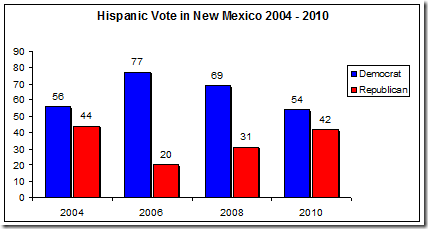New Mexico has historically provided some high drama during presidential elections, and is often referred to as both a bell-weather and swing state. In fact, Al Gore squeaked out a razor thin 366 vote victory in New Mexico during the 2000 election, and in 2004 George W. Bush won by just under 6,000 votes in the state. It was therefore surprising to see President Obama win by a relative land-slide of nearly 126,000 votes in 2008. As detailed very nicely in a recent New York Times Presidential Geography series, the increase in Latino population within the state helped fuel the President’s large vote margin in New Mexico. As depicted in the figure below, as the Democratically leaning Hispanic voting population grows within the state’s electorate, the state has become less competitive in presidential years. Latinos make up nearly half of the state’s population, and more importantly, comprise nearly 40% of New Mexico’s electorate, the highest ratio in the nation for both categories. Consequently, elections in New Mexico are essentially always dependent on the voting behavior of the state’s Hispanic community.
Although the 2012 presidential election is not projected to be a tight one here in New Mexico, there are many things to pay attention to in New Mexico down the stretch. For example, will Governor Susana Martinez be able to help Romney gain some ground on the President in her own backyard? Although it does not appear as though Governor Martinez will be Romney’s running mate on the GOP ticket, Martinez was recently named to Romney’s “Juntos con Romney” Latino outreach committee. It will be interesting to see if Martinez, who has been critical of Romney’s self-deportation strategy and a recent supporter of the Dream Act, can persuade Romney to soften his stance and tone on immigration policy.
Governor Martinez has been very popular among New Mexicans to this point in her first term, but has also received a substantial amount criticism. In fact, Martinez made immediate headlines for her aggressive approach to immigration policy, which included an executive order issued on her first day in office that requires state law enforcement officials to verify the citizenship status of individuals arrested, and several failed efforts to repeal a law allowing undocumented immigrants to acquire driver’s licenses in the state. Both policy actions were attempts to do away with laws enacted by her predecessor, and fellow Latino, Bill Richardson.
Governor Martinez may not be the only Latina elected official in New Mexico who could have a marked impact on the winners of the state’s 2012 general election. Although the clear focus of the 2010 election here in New Mexico was the election of the nation’s first Latina Governor, Susana Martinez, there was another historic victory that has had a marked substantive impact on state policy. Dianna Duran became the first Republican Secretary of State elected in New Mexico since 1928. The Latino Decisions 2010 Election Eve Poll indicated that both Duran and Martinez captured an impressive percentage of the Latino vote in 2010, 38% for Martinez and 37% for Duran. Like Martinez, Secretary of State Duran has not been a stranger to controversy, particularly as it relates to immigration policy in New Mexico.
Secretary Duran sent a shock-wave through the state when she speculated that there were as many as 64,000 non-citizens registered to vote in the state after cross-checking voter registration files with the state motor vehicle database. Duran later announced that her office had evidence that 117 undocumented immigrants had obtained driver’s licenses and registered to vote in New Mexico, with 37 voting in elections between 2003-2010. Following a law suit by the ACLU of New Mexico and substantial pressure from other interest groups to produce the results of her office’s report, Duran’s office clarified that there were only 2 confirmed cases of foreign-nationals being registered to vote, and only one individual who actually voted- albeit unintentionally. Duran and Martinez have also unsuccessfully pushed to pass a voter ID law in New Mexico that would require voters to present photo ID before being allowed to vote in person.
These efforts to clean the voter rolls in New Mexico sound strikingly similar to Florida’s effort to compare their voter registration list to DMV citizenship data. My colleague Casey Klofstad recently wrote about this issue in Florida, contending that these actions could suppress the Latino vote in that state. It seems highly plausible that the significant efforts of Governor Martinez and Secretary of State Duran to ensure that New Mexico is not viewed a sanctuary state for undocumented immigrants could have a negative impact on Latino turnout as well. At a minimum, these highly publicized actions have likely increased perceptions among the public that voter fraud, and particularly fraud committed by undocumented immigrants, is rampant in the state.
More recently, Secretary Duran decided to do away with the straight-party ticket option in New Mexico in time for the 2012 general elections. While Duran’s office indicated that their analysis of voting trends in 2010 shows an equal split in the use of straight-ticket voting during the 2010 election, one has to wonder why the first Republican Secretary of State in New Mexico in over 80 years would make this move if the GOP did not perceive that they would acquire an electoral advantage. While these developments may not decide the winner of New Mexico presidential contest given the projection numbers I started with, they could have a significant impact on the future of the voter ID and driver’s license laws, as all seats in the Democratically controlled legislature are up for grabs in 2012.
Gabriel R. Sanchez is an Associate Professor of Political Science at the University of New Mexico and Director of Research



